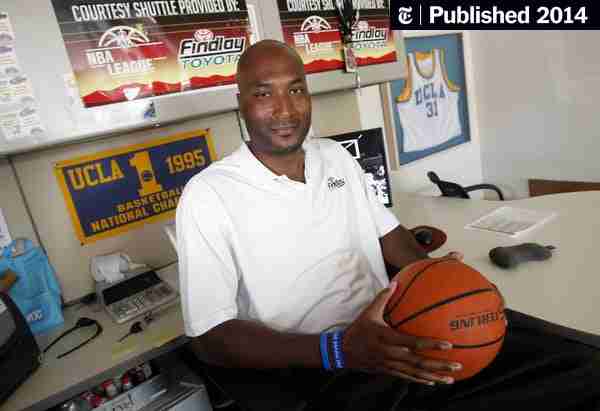In the court of public opinion, the NCAA has been on trial for some time now.
Critics say college sports have become a big business that brings in billions of dollars on the backs of unpaid athletes. Its defenders argue that the players are student-athletes who are fairly compensated with scholarships and the opportunity to compete.
That contentious debate will be examined in federal court starting Monday, when former UCLA basketball star Ed O’Bannon’s antitrust lawsuit against the NCAA goes to trial.
In court, O’Bannon’s lawyers will ask U.S. District Court Judge Claudia Wilkin to rule that the NCAA cannot prohibit college players from sharing in profits from broadcasts and video games in which they – or their image – are presented.
Nearly five years ago, O’Bannon sued the NCAA, as well as EA Sports, the video game maker, and the Collegiate Licensing Company, which manages licensing rights for many universities. O’Bannon’s lawyers reached a $40 million settlement with EA Sports and the Collegiate Licensing Company – but the lawsuit against the NCAA continues.
Q. Who is Ed O’Bannon and why is he suing the NCAA?
A. O’Bannon, 41, led UCLA to the 1995 NCAA championship during his senior season. He was the tournament’s Most Outstanding Player and a consensus All-American. He was drafted ninth by the New Jersey Nets, but his career fizzled.
Many years later, O’Bannon, now a car salesman in the Las Vegas area, recognized himself in a video game and was troubled that his likeness was being used without his consent – or its payment.
O’Bannon then became the lead plaintiff in the antitrust suit filed in July 2009. He was later joined by current and former players, including Bill Russell and Oscar Robertson, and the lawsuit was certified as a class action.
Q. What will O’Bannon’s lawyers argue? What do they hope to accomplish with this trial?
A. Plaintiffs’ attorneys will seek to prove that the NCAA violated antitrust laws by conspiring with its partners to prevent college athletes from being paid for the use of their names, images and likenesses in broadcasts and video games.
They are seeking an injunction that ends NCAA rules prohibiting universities from paying players for their publicity rights. “Free market forces would then determine whether schools unilaterally decide to compensate college athletes,” the lawyers explain in a pretrial filing.
Q. What is the NCAA defense?
A. The NCAA will argue that the appeal of college sports lies in amateurism and that if its amateur rules are compromised, its future will be jeopardized. Lawyers will argue that the NCAA rules protect the competitive balance between schools and conferences and also allow colleges to offer many more scholarships.
Judge Wilken said Title IX, the gender equity rules governing higher education, would have no impact on this case. This is for Division I and Football Bowl Subdivision men’s basketball athletes only.
Q. How will this trial be set up?
A. Judge Wilkin will preside over the trial and decide whether to issue the injunction, likely this summer. The trial is expected to last approximately 15 days.
There will be no jury, so the way lawyers present their cases will be much less theatrical than what we sometimes see on television. For example, there will be no opening statements.
The trial will not be televised, per federal court rules.
Q. Who are the lawyers who will defend the arguments of both parties?
A. The players’ lead attorney is Michael Hausfeld, president of Washington-based Hausfeld LLP. He has been a litigator for over 40 years and has a number of notable cases to his credit. He will be joined by four other lawyers from several law firms.
For the NCAA, the lead attorney in the lawsuit will be Glenn Pomerantz, a Los Angeles-based partner at Munger, Tolles & Olson. Pomerantz, who recently worked for the Justice Department as it sought to block the merger of AT&T and T-Mobile, will work with a team of several other attorneys.
Donald Remy, the NCAA’s legal director, will not be part of the trial team but is expected to be present in the courtroom. Remy, who served as vice president of litigation at Fannie Mae from 2000 to 2006, joined the NCAA in 2011 and led efforts to defend the organization against a range of legal threats.
Q. Many witnesses will be called to testify on both sides. Who are some of them?
A. The list of plaintiffs includes more than a dozen former players, including O’Bannon, Robertson and Russell, who will speak about their experiences as college athletes. Expert economists will also be called in.
The NCAA’s witness list includes a host of organizational officials, like longtime executive David Berst, as well as conference commissioners (Big Ten’s Jim Delany), university presidents (Mary Sue Coleman of Michigan) and athletic directors (Bernard Muir of Stanford).
Mark Emmert, president of the NCAA, is on both witness lists. He will be called by the defense but questioned directly by both parties.
Q. What happens if O’Bannon wins? Will there still be a college football season?
A. Probably yes. But things could get interesting quickly. If the judge issues the injunction requested by the players’ attorneys, it would prevent the NCAA and its members from maintaining the status quo in their television and other licensing agreements. The NCAA would almost certainly appeal the decision, and a higher court could stay the injunction while it reviews the case.
As for the long-term impact, a verdict in O’Bannon’s favor could give colleges or conferences the opportunity to make financial offers to high school recruits for their advertising rights, in order to lure them to campus.
